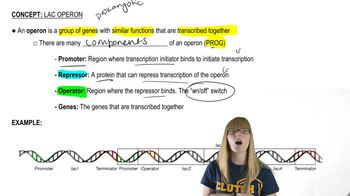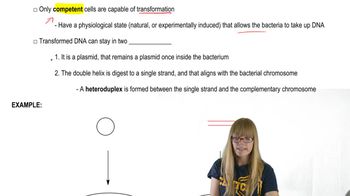Glucose concentration can regulate the lac operon?
Table of contents
- 1. Introduction to Genetics51m
- 2. Mendel's Laws of Inheritance3h 37m
- 3. Extensions to Mendelian Inheritance2h 41m
- 4. Genetic Mapping and Linkage2h 28m
- 5. Genetics of Bacteria and Viruses1h 21m
- 6. Chromosomal Variation1h 48m
- 7. DNA and Chromosome Structure56m
- 8. DNA Replication1h 10m
- 9. Mitosis and Meiosis1h 34m
- 10. Transcription1h 0m
- 11. Translation58m
- 12. Gene Regulation in Prokaryotes1h 19m
- 13. Gene Regulation in Eukaryotes44m
- 14. Genetic Control of Development44m
- 15. Genomes and Genomics1h 50m
- 16. Transposable Elements47m
- 17. Mutation, Repair, and Recombination1h 6m
- 18. Molecular Genetic Tools19m
- 19. Cancer Genetics29m
- 20. Quantitative Genetics1h 26m
- 21. Population Genetics50m
- 22. Evolutionary Genetics29m
12. Gene Regulation in Prokaryotes
Lac Operon
Problem 1d
Textbook Question
How do we know that the lac repressor is a protein?
 Verified step by step guidance
Verified step by step guidance1
Understand the context: The lac repressor is a key regulatory protein in the lac operon system of *E. coli*. It binds to the operator region to inhibit transcription of genes involved in lactose metabolism. To determine that the lac repressor is a protein, experimental evidence is required.
Step 1: Review the biochemical isolation of the lac repressor. Scientists used techniques such as affinity chromatography to isolate the lac repressor from bacterial cells. This method relies on the specific binding of the repressor to DNA sequences containing the operator region.
Step 2: Analyze the molecular composition of the isolated lac repressor. Once isolated, the lac repressor was subjected to protein analysis techniques, such as gel electrophoresis and amino acid sequencing, which confirmed that it is composed of amino acids, the building blocks of proteins.
Step 3: Examine the functional properties of the lac repressor. Proteins are known to have specific three-dimensional structures that allow them to perform their functions. The lac repressor was shown to bind specifically to the operator DNA sequence, a characteristic behavior of proteins with DNA-binding domains.
Step 4: Consider the effects of mutations in the lacI gene. The lacI gene encodes the lac repressor. Mutations in lacI that disrupt the production of the repressor or alter its structure result in changes to the regulation of the lac operon, further supporting that the lac repressor is a protein encoded by this gene.
 Verified video answer for a similar problem:
Verified video answer for a similar problem:This video solution was recommended by our tutors as helpful for the problem above
Video duration:
1mPlay a video:
Was this helpful?
Key Concepts
Here are the essential concepts you must grasp in order to answer the question correctly.
Lac Operon
The lac operon is a well-studied model of gene regulation in bacteria, particularly in Escherichia coli. It consists of genes responsible for the metabolism of lactose and is controlled by the lac repressor protein. Understanding the lac operon is crucial for grasping how gene expression is regulated in response to environmental changes, such as the presence or absence of lactose.
Recommended video:
Guided course

Lac Operon Overview
Protein Function and Identification
Proteins are essential biomolecules that perform a variety of functions in living organisms, including acting as enzymes, structural components, and regulators of gene expression. The identification of the lac repressor as a protein was established through various biochemical techniques, such as gel electrophoresis and affinity chromatography, which separate and characterize proteins based on their size and binding properties.
Recommended video:
Guided course

Proteins
Experimental Evidence
Experimental evidence is critical in molecular biology for validating hypotheses about biological processes. In the case of the lac repressor, experiments such as the use of mutations, protein purification, and functional assays demonstrated that the repressor binds to the operator region of the lac operon, inhibiting transcription when lactose is absent, thereby confirming its role as a protein.
Recommended video:
Guided course

Transformation
Related Videos
Related Practice
Multiple Choice
649
views
5
rank


